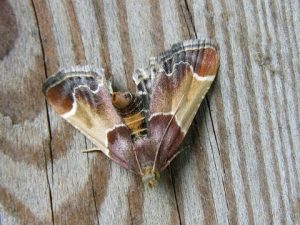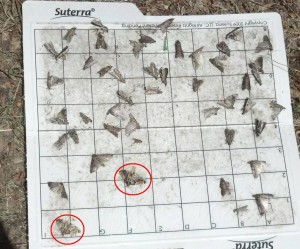
I have been hearing multiple reports of high counts of Navel Orangeworm (NOW) moths trapped with the new Suterra Biolure. We have placed our traps and have had high trap counts as well. In our liners, however, we have found two different moths – one being NOW (Amyelois transitella) and the other being a meal moth (Pyralis farinalis). Both of these moths are within the same family (Pyralidae) and can be confused.
The meal moth can be distinguished from NOW by two features – the light brown color and the dark brown bands on the wings. Speaking with a Suterra rep, this was expected as these moths are attracted to the same sex pheromone as NOW.

Trap counts can range depending upon location – in one locations we trapped 20 meal moths, while a second location we trapped only 2. Suterra doesn’t know why populations vary, but suspect that proximity to hullers or warehouses might influence populations. A comparison of meal moths next to NOW in a liner can be seen in figure 2.
We plan to follow the trap counts of NOW, meal moth, and NOW eggs (using egg traps) todetermine if there is any type of relationship. To date, we have found higher NOW moth counts than expected (>30/week), and very low egg counts (<2/week) at two locations. This suggests that the biolure may be more sensitive, but the exact relationship of moth count to NOW infestation is still needed to determine spray thresholds.


David Doll
April 27, 2013Devin Caroll (Bio Ag Services) has sent me an email with the following:
“The meal moth is often seen in the traps, but it is easy to distinguish from NOW.
But there is another brown moth caught with the NOW lures that is the same size and shape as NOW and can be more easily confused. The coloration is different, but you have to look close.
I have been catching as many or more of these brown moths as the NOW.
The abundance tracks NOW, where there are more NOW, there are more of these brown moths.
Females of these moths are also attracted to the ground up pistachio/almond meal in Peterson Traps.
So far I have not found anyone who knows the species of this moth…”
Devin also posted some pictures on bugguide:
“Here’s the meal moth http://bugguide.net/node/view/599060/bgimage
Here’s the brown moth http://bugguide.net/node/view/757913.
I have also attached pictures of a male and a female.”
Thanks Devin!
As we learn more, we will continue to post updates.
David Doll
May 4, 2013UPDATE: The third moth found within traps has been identified as navel orange worm.
David Doll
May 4, 2013UPDATE: Suterra has indicated that the new NOW Biolure is available for use. Contact your local Suterra Rep for more information.